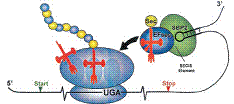Biochemistry, Department of

Vadim Gladyshev Publications
Document Type
Article
Date of this Version
January 2007
Abstract
Selenocysteine (Sec) is cotranslationally inserted into protein in response to UGA codons and is the 21st amino acid in the genetic code. However, the means by which Sec is synthesized in eukaryotes is not known. Herein, comparative genomics and experimental analyses revealed that the mammalian Sec synthase (SecS) is the previously identified pyridoxal phosphate-containing protein known as the soluble liver antigen. SecS required selenophosphate and Ophosphoseryl- tRNA [Ser]Sec as substrates to generate selenocysteyl-tRNA [Ser]Sec. Moreover, it was found that Sec was synthesized on the tRNA scaffold from selenide, ATP, and serine using tRNA [Ser]Sec, seryl-tRNA synthetase, Ophosphoseryl- tRNA [Ser]Sec kinase, selenophosphate synthetase, and SecS. By identifying the pathway of Sec biosynthesis in mammals, this study not only functionally characterized SecS but also assigned the function of the O-phosphoseryl-tRNA [Ser]Sec kinase. In addition, we found that selenophosphate synthetase 2 could synthesize monoselenophosphate in vitro but selenophosphate synthetase 1 could not. Conservation of the overall pathway of Sec biosynthesis suggests that this pathway is also active in other eukaryotes and archaea that synthesize selenoproteins.


Comments
Published in PLoS Biology | January 2007 | Volume 5 | Issue 1. Permission to use. www.plosbiology.org